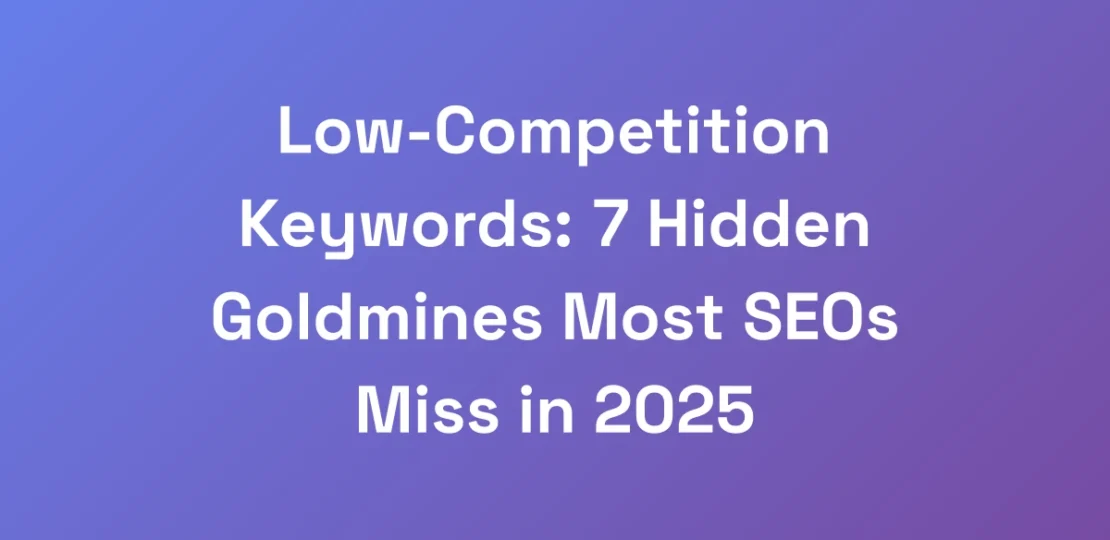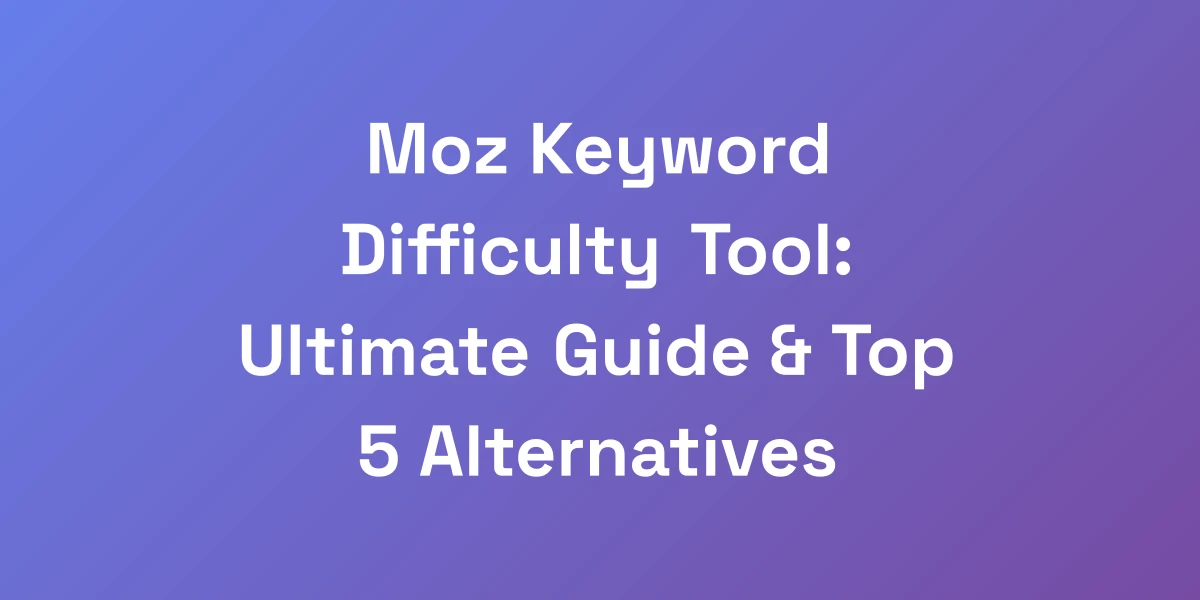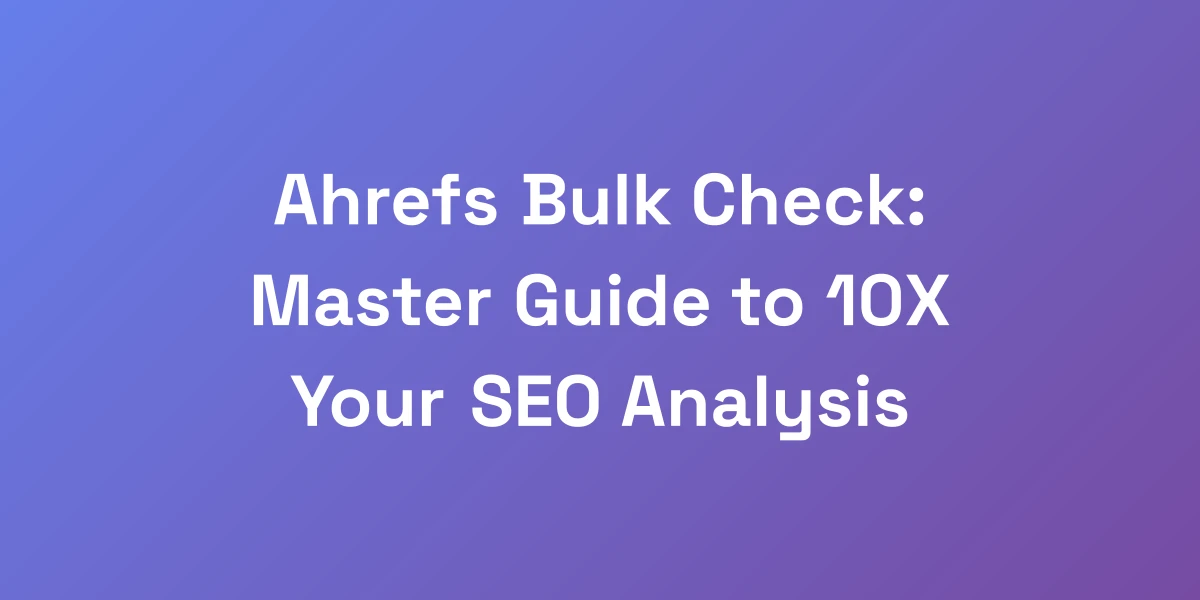Low-Competition Keywords: 7 Hidden Goldmines Most SEOs Miss in 2025
March 13, 2025 | by [email protected]

Ever feel like you’re stuck in a never-ending race for the same high-competition keywords everyone else is chasing?
We’ve all been there—spending countless hours optimizing for terms that seem more like battlegrounds than opportunities.
It’s frustrating, right?
But what if I told you there are hidden goldmines out there, waiting for those savvy enough to dig deeper?
We’re about to uncover the 7 hidden goldmines most SEOs miss in 2025, the low-competition keywords that can exponentially grow your organic traffic without the relentless struggle against established competitors.
Ready to shift your SEO strategy from the crowded highways to the quiet, lucrative backstreets? Let’s dive in.
Why Most People Fail at Finding True Low-Competition Keywords
Let me hit you with some truth: 90% of SEOs are looking for low-competition keywords in all the wrong places.
They’re using the same tools, following the same “gurus,” and wondering why they’re not seeing results.
Here’s the reality—the real goldmines aren’t where everyone else is digging.
We’ve built multiple 7-figure businesses by targeting keywords others overlooked, and we’re about to show you exactly how to find these hidden opportunities.
These are the keywords that can exponentially grow your organic traffic without fighting an uphill battle against established competitors.
The Common Misconceptions About Keyword Difficulty
First off, let’s bust some myths.
Many believe that high search volume equals high competition. Not always true.
- Myth: Only high-volume keywords matter.
- Reality: Long-tail keywords, though lower in volume, often have higher conversion rates.
Another misconception is that keyword difficulty scores from tools like Ahrefs or SEMrush are absolute indicators.
These metrics provide a starting point, but they don’t capture the full picture.
- Myth: A high difficulty score means no chance of ranking.
- Reality: With the right strategy, even competitive keywords can be conquered.
Understanding these misconceptions is crucial for shifting your focus to truly low-competition keywords that offer real value.
Why Traditional Keyword Research Tools Are Limiting Your Success
Traditional keyword research tools have their place, but they’re not the be-all and end-all. Incorporating SEO automation can enhance your keyword research by handling repetitive tasks and providing deeper insights.
They often miss the nuances that separate good keywords from great ones.
- Limited Scope: They focus heavily on volume and difficulty without considering intent.
- Overwhelmed by Data: Too much information can lead to analysis paralysis.
We utilize advanced techniques that go beyond these tools, tapping into semantic search and entity optimization to uncover those hidden opportunities.
This approach ensures that we’re not just finding keywords, but finding the right keywords that align perfectly with user intent.
The Real Definition of a Low-Competition Opportunity
So, what exactly defines a low-competition keyword?
It’s more than just a keyword with fewer competitors. It’s about finding terms that have:
- High Search Intent: Users are looking for something specific and actionable.
- Low Market Sophistication: The market hasn’t fully capitalized on these terms yet.
When these elements converge, you have a low-competition opportunity that can drive targeted traffic with minimal effort.
These keywords often fall into the “opportunity gaps” where high user intent meets low competition.
Understanding Search Intent vs. Competition Metrics
Understanding search intent is paramount.
It’s not enough to find a keyword with low competition; you need to ensure it matches what your audience is actively seeking.
For instance, a keyword might have low competition, but if users aren’t specifically looking for what you offer, it won’t convert.
- Informational Intent: Users are seeking knowledge or answers.
- Transactional Intent: Users are ready to make a purchase or take action.
- Navigational Intent: Users are looking to reach a specific site or page.
By aligning your keyword strategy with these intents, you ensure that the traffic you attract is not just high in volume but also high in quality.
The Psychology Behind Successful Keyword Selection
There’s a psychological aspect to keyword selection that often goes overlooked.
Understanding the mindset of your audience can lead you to keywords that resonate deeply and drive engagement.
- Emotional Triggers: Keywords that tap into emotions can significantly boost click-through rates.
- Pain Points: Addressing specific problems your audience faces makes your content more relevant.
- Desire and Aspiration: Keywords that reflect what your audience aspires to can lead to higher conversions.
When you combine these psychological insights with your keyword research statistics, you create content that not only attracts traffic but also converts it effectively.
The 7-Figure Framework for Finding Untapped Keyword Opportunities
Stop wasting time with outdated keyword research methods.
We’re about to share the exact framework we use in our $100M+ portfolio companies to identify keywords that are not just low-competition, but also highly profitable.
This isn’t theory—it’s a battle-tested system that consistently delivers results.
The key is understanding that true low-competition keywords exist in what we call opportunity gaps—spaces where high user intent meets low market sophistication.
The Opportunity Gap Analysis Method
First, let’s talk about the Opportunity Gap Analysis Method.
This involves identifying gaps in the content that currently exist in the SERPs.
- Step 1: Analyze the existing top-ranking pages for your target keyword.
- Step 2: Identify what’s missing—whether it’s depth, specific angles, or multimedia elements.
- Step 3: Create content that fills these gaps, offering something uniquely valuable.
By focusing on these gaps, we ensure that our content stands out, addressing needs that others have overlooked.
This method has been pivotal in driving significant traffic and conversions for our businesses.
Leverage Search Intent Patterns
Understanding and leveraging search intent patterns is critical.
It’s not just about what people are searching for, but why they’re searching for it.
- Identify Trends: Use tools to spot emerging search trends that align with your niche.
- Map Intent: Categorize keywords based on the type of intent—informational, transactional, or navigational.
- Tailor Content: Create content that directly addresses the specific intent behind each keyword.
By mapping out these patterns, we can target keywords that not only attract traffic but also drive meaningful engagement and conversions.
Using Advanced SERP Analysis Techniques
Advanced SERP analysis goes beyond the basics of keyword research.
We delve deep into the structure and features of the search engine results pages to uncover opportunities.
- Feature Spotting: Identify SERP features like featured snippets, People Also Ask, and video carousels.
- Competitor Evaluation: Analyze the strength and weaknesses of top-ranking competitors in each SERP feature.
- Content Gaps: Determine what types of content are missing or underrepresented in the current SERPs.
By mastering these techniques, we can target keywords that have lower competition within these SERP features, giving us a competitive edge.
Identifying Keyword Profitability Indicators
Not all low-competition keywords are created equal. We need to assess their profitability.
- Search Volume: Ensure the keyword has enough search volume to warrant targeting.
- Conversion Potential: Evaluate whether the keyword attracts users who are likely to convert.
- Monetization Opportunities: Consider how the keyword can be integrated into your monetization strategy, whether through ads, affiliate links, or product sales.
By focusing on these indicators, we can prioritize keywords that not only attract traffic but also drive revenue.
The Competition Quality Assessment Framework
Assessing the quality of competition is essential.
We’re not just looking at the number of competitors, but the quality of their content and their authority.
- Content Quality: Analyze the depth, accuracy, and engagement level of competitors’ content.
- Domain Authority: Check the overall authority and trustworthiness of the competing domains.
- Backlink Profiles: Evaluate the quality and quantity of backlinks pointing to competitor content.
This framework helps us identify opportunities where competition is not just low in quantity but also lacks in quality, making it easier for us to rank higher.
Advanced Technical Methods to Validate Low-Competition Keywords
Here’s where we separate the amateurs from the pros.
Most people stop at basic keyword metrics, but real money is made in the details.
We’re going to show you how to use advanced technical analysis to validate your keyword opportunities before investing time and resources.
This is the same process we use to identify keywords that drove millions in revenue for our portfolio companies.
Advanced SERP Feature Analysis
Advanced SERP feature analysis involves a deep dive into the various elements that populate the search results.
- Snippet Dominance: Identify if featured snippets are prevalent and analyze how to optimize for them.
- Local Pack Insights: For geo-specific keywords, understand the local SEO landscape.
- Rich Media Utilization: Determine the presence of videos, images, and other rich media that can be leveraged.
By dissecting these features, we can tailor our content to fit seamlessly into the existing SERP environment, increasing our chances of ranking.
Domain Authority vs. Content Quality Assessment
When validating low-competition keywords, it’s crucial to balance domain authority with content quality.
- Domain Authority: High authority domains have a distinct advantage, but they aren’t unbeatable.
- Content Quality: Superior content can outperform even higher authority sites if it meets user intent better.
- Combination Strategy: Use a combination of improving your domain authority and creating top-notch content to maximize your ranking potential.
Our approach ensures that we’re not just competing on keywords but also on the value we provide to our audience.
Backlink Profile Analysis Techniques
Backlinks remain a cornerstone of SEO. Analyzing backlink profiles can reveal the true competitiveness of a keyword.
- Link Quantity vs. Quality: Focus on obtaining high-quality backlinks rather than sheer numbers.
- Competitor Backlink Insights: Analyze where competitors are getting their backlinks and identify gaps you can exploit.
- Opportunity Identification: Discover potential backlink opportunities through niche-specific directories, guest posting, and partnerships.
By mastering these techniques, we can build a robust backlink profile that supports our keyword strategy and enhances our site’s authority.
Content Gap Identification Methods
Content gaps are the gaps between what users are searching for and what’s currently available.
- User Intent Fulfillment: Ensure your content fully satisfies the user’s query.
- Comprehensive Coverage: Cover all aspects of the topic, leaving no stone unturned.
- Unique Perspectives: Offer insights or angles that competitors haven’t explored.
By identifying and filling these gaps, we create content that stands out, providing unparalleled value to our audience.
Commercial Intent Validation Process
Validating the commercial intent behind keywords ensures that you’re targeting terms that can drive revenue.
- Transaction Indicators: Look for keywords that indicate a readiness to purchase, such as “buy,” “discount,” or “review.”
- Monetization Pathways: Identify how you can monetize traffic from these keywords, whether through product sales, affiliate marketing, or ads.
- Competitive Analysis: Ensure that the commercial intent aligns with what competitors are offering and how.
This process guarantees that the keywords you target aren’t just bringing in traffic but are also contributing to your bottom line.
Implementation Strategies That 10x Your Results
Finding low-competition keywords is only half the battle.
The real magic happens in how you implement them strategically to maximize their impact. For small businesses, leveraging digital marketing strategies can further enhance the effectiveness of your keyword targeting.
We’ve seen businesses completely transform their traffic and revenue by properly executing these opportunities.
Let us show you the exact process we use to turn these keywords into predictable revenue streams.
Content Optimization Framework
Optimization is the key to turning a good keyword into a great revenue driver.
- Comprehensive Content: Ensure your content covers all aspects of the keyword topic thoroughly.
- Keyword Placement: Integrate keywords naturally into titles, headers, meta descriptions, and throughout the content.
- Multimedia Integration: Use images, videos, and infographics to enhance user engagement and retention.
Our framework doesn’t just optimize for search engines; it optimizes for readers, ensuring they find exactly what they need and stay engaged.
Strategic Internal Linking Methods
Internal linking is often underestimated but incredibly powerful.
- Content Clusters: Create clusters of related content that interlink, boosting overall site authority.
- User Navigation: Guide users through your site smoothly, increasing the time they spend on it.
- SEO Benefits: Enhances the SEO value by distributing link equity across your site efficiently.
By strategically linking your content, you not only improve SEO but also provide a better user experience, leading to higher conversions.
Authority Building Techniques
Building authority is essential for ranking high in search results.
- Expert Content: Publish content that showcases your expertise and provides real value to your audience.
- Consistent Publishing: Regularly update your site with fresh, high-quality content to maintain and grow your authority.
- Community Engagement: Participate in industry forums, webinars, and other platforms to establish yourself as a thought leader.
Authority drives trust, and trust drives clicks and conversions. For agencies looking to scale, adopting a digital marketing strategy tailored for agencies can provide a significant advantage.
Conversion Rate Optimization for Keywords
Once you’ve attracted the right traffic, converting that traffic is where the real game is played.
- Clear CTAs: Ensure your calls-to-action are clear, compelling, and strategically placed.
- Landing Page Optimization: Tailor your landing pages to match the intent of the keyword, making it easy for users to take the desired action.
- Testing and Iteration: Continuously test different elements of your pages to find what works best.
Optimizing for conversions ensures that your traffic translates into tangible results, maximizing the ROI of your SEO efforts.
Scaling Your Keyword Strategy
Once you have a winning strategy, scaling it is the next step.
- Process Automation: Use tools and software to streamline your keyword research and content creation processes.
- Team Expansion: Build a team to handle various aspects of SEO, from content creation to technical optimization.
- Continuous Learning: Stay updated with the latest SEO trends and adapt your strategies accordingly.
Scaling ensures that you’re not just capitalizing on a few keywords but building a robust strategy that covers multiple niches and opportunities.
RELATED POSTS
View all


